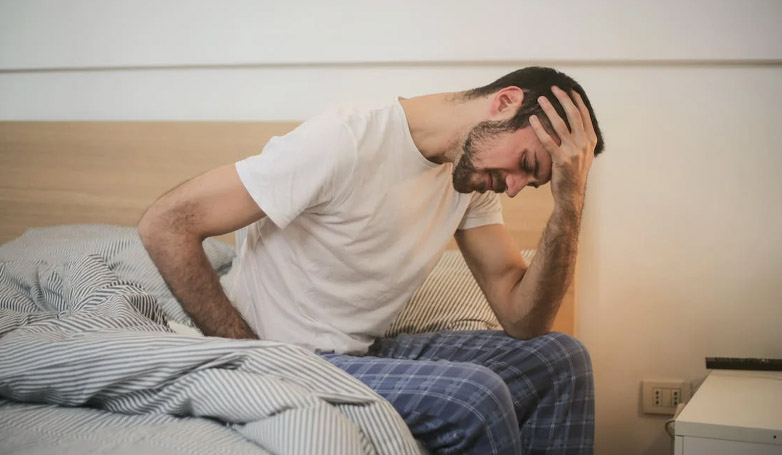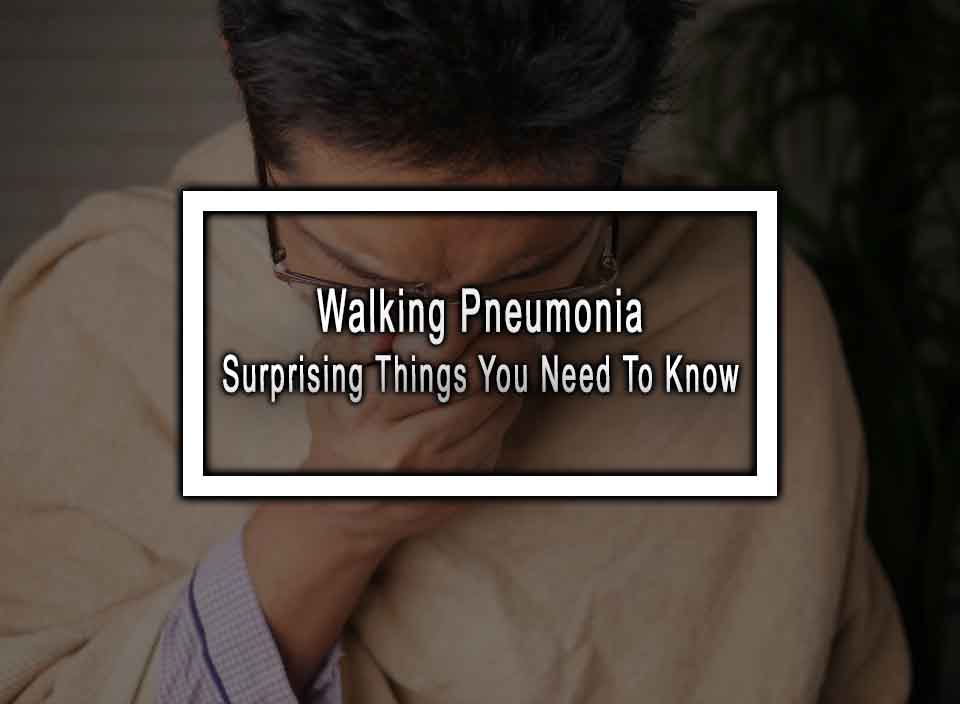Learn All About Walking Pneumonia!
Are you coughing up a storm but still on your feet, juggling daily chores as if it’s just another cold? Watch out, because you might be buddies with an invisible culprit called ‘Walking Pneumonia.’ Often flying under the radar, this milder form of pneumonia can make you feel rundown without knocking you off your feet. Get ready to strut through the must-know details about this sneaky health intruder. In this insightful stroll, we’ll unravel Essential Facts About Walking Pneumonia’ that you should tuck into your knowledge backpack right away!
What is Walking Pneumonia?
Walking pneumonia, also known as atypical pneumonia, is a milder form of pneumonia that typically presents with mild symptoms. It is caused by bacteria, such as Mycoplasma pneumoniae, or viruses, like the influenza virus. The term “walking pneumonia” refers to the fact that people with this condition are often still able to function and complete daily activities, even with the infection.
Sign And Symptoms

Walking pneumonia, also known as atypical pneumonia, is a milder form of pneumonia that is often caused by certain bacteria like Mycoplasma pneumoniae. People with walking pneumonia might not feel sick enough to stay in bed or even realize they have pneumonia. Here are some of the common signs and symptoms associated with walking pneumonia:
- Mild flu-like symptoms: Walking pneumonia may start with symptoms similar to those of a cold or flu, which then gradually develop into pneumonia.
- Persistent dry cough: A cough that is not productive, meaning it doesn’t produce mucus, is a typical sign of walking pneumonia and can be persistent, lasting for several weeks.
- Chest pain: Patients can experience chest pain that is sharp or stabbing and gets worse when taking a deep breath or coughing.
- Shortness of breath or rapid breathing: Persons with walking pneumonia may have difficulty catching their breath or may breathe faster than usual, especially during physical activities.
- Mild fever: Fever associated with walking pneumonia is generally lower than that with typical pneumonia and may be accompanied by chills.
- Fatigue: Those afflicted often feel tired or weak, which might be more noticeable with physical exertion.
- Sore throat and headaches: These symptoms are less specific but can also occur in walking pneumonia.
- Muscle aches: Some individuals report aching muscles, which is another non-specific symptom.
Common Causes

Walking pneumonia, also known as atypical pneumonia, is a milder form of pneumonia that is not usually severe enough to require bed rest or hospitalization. It is often caused by bacteria, viruses, and at times by fungi or various chemicals. Some of the common causes of walking pneumonia include:
- Mycoplasma Pneumoniae: This is the most common cause of walking pneumonia, especially in children and young adults. This bacterium causes a condition known as Mycoplasma pneumonia, which is typically mild but persistent.
- Chlamydia Pneumoniae: Another type of bacteria that can lead to walking pneumonia is Chlamydia pneumoniae, which can infect people of all ages but more commonly affects school-aged children and young adults.
- Legionella Pneumophila: Legionella, the bacterium that causes Legionnaires’ disease, can also produce milder respiratory symptoms known as Pontiac fever, which can sometimes be classified as a form of walking pneumonia.
- Respiratory Syncytial Virus (RSV): While RSV typically causes mild, cold-like symptoms, it can occasionally lead to a lower respiratory infection like walking pneumonia, especially in young children and older adults.
- Viruses: Many of the viruses that cause the common cold or flu can also cause walking pneumonia, especially in children and people with compromised immune systems.
- Fungi: In certain geographical regions, fungi such as Histoplasma capsulatum, Coccidioides immitis, and Blastomyces dermatitidis can cause walking pneumonia-like symptoms, particularly in immunocompromised individuals.
- Exposure to Chemicals: Inhaling small particles or chemicals, such as those found in workplace environments or polluted areas, may lead to atypical pneumonia.
- Pneumocystis Jirovecii: This fungus is a rare cause of walking pneumonia, mostly affecting people with weakened immune systems, such as those with HIV/AIDS.
How do you catch walking pneumonia?
Walking pneumonia, caused by the bacteria Mycoplasma pneumoniae, is a milder form of pneumonia that is contagious. It spreads through respiratory droplets when an infected person coughs or sneezes. To catch walking pneumonia, you could:
- Be in close contact with someone who is infected.
- Inhale infected droplets in the air after someone coughs or sneezes.
- Share utensils or drinks with someone who has the infection.
- Touch surfaces contaminated with the bacteria and then touch your nose or mouth.
How long am I contagious if I have walking pneumonia?
Walking pneumonia features an incubation period that can run anywhere from 1 to 4 weeks. This means the bacteria can play hide-and-seek in your body for up to a month before showing any symptoms, enabling them to spread silently like a secret agent.
Diagnosis

Diagnosing walking pneumonia can be quite the puzzle. Blood tests, chest X-rays, and sputum analysis are common investigative tools doctors use to track down the source of your persistent cough and undercover fatigue.
Complications
Rarely, walking pneumonia can put on its running shoes and lead to complications like bronchitis or, in more severe cases, even hospitalization-required pneumonia. So, keep an eye out for symptoms that escalate or linger longer than your average cold.
Who’s at risk? Recon on Vulnerable Groups
While anyone can contract walking pneumonia, it plays favorites with kids and young adults. Older adults and those with weakened immune systems should also be on high alert, as they’re more susceptible to turning a subtle stroll with pneumonia into a sprint to the doctor.
Tips To Avoid

You can take steps to sidestep walking pneumonia by practicing good hygiene and keeping your immune system strong. Here are some tips to help avoid walking pneumonia:
Practice good hygiene
- Wash your hands frequently with soap and water for at least 20 seconds.
- Use hand sanitizer if soap and water are not available.
- Avoid touching your face, especially the eyes, nose, and mouth, with unwashed hands.
Stay healthy
- Maintain a healthy immune system by eating a balanced diet, getting regular exercise, and getting enough sleep.
- Keep your vaccinations up to date, including the pneumococcal and flu vaccines.
Avoid close contact
- Avoid close contact with people who are sick or showing symptoms of respiratory illness.
- If you’re sick, stay home from work or school to prevent spreading the infection to others.
- When coughing or sneezing, cover your mouth and nose with a tissue or your elbow to prevent dispersing droplets into the air.
Don’t Smoke
- Avoid smoking, as it damages the respiratory system and increases the risk of respiratory infections.
- Stay clear of secondhand smoke and places with high air pollution, which can also weaken your lung’s defenses.
Clean and disinfect
- Regularly clean and disinfect surfaces that are frequently touched in your home, school, or workplace.
- Use EPA-registered disinfectants that can kill a broad range of bacteria and viruses.
Manage chronic conditions
Keep chronic conditions such as asthma, diabetes, or heart disease well managed, as they can increase the risk of respiratory infections.
Consider wearing masks
If walking pneumonia or other respiratory illnesses are prevalent in your area, consider wearing a mask in crowded places.
Stay informed
Keep informed about any outbreaks of pneumonia or similar respiratory illnesses in your area and heed the advice of health authorities.
Treatment Tactics

If bacteria are the perpetrators, antibiotics can usually shoo them away. However, walking pneumonia caused by viruses won’t respond to antibiotics, so treatment focuses on rest, fluids, and over-the-counter medications to ease the symptoms.
Most cases of walking pneumonia are managed on an outpatient basis due to the milder nature of symptoms. Here are the basic treatment tactics:
Antibiotics
- Specifically selected antibiotics are the mainstay treatment for walking pneumonia because it is often caused by bacterial pathogens.
- Macrolides such as azithromycin or clarithromycin are commonly used because of their effectiveness against Mycoplasma pneumoniae.
- In some cases, doxycycline or fluoroquinolones like levofloxacin or moxifloxacin might be prescribed, especially for adults.
- Treatment duration varies but often spans from 5 to 14 days depending on the antibiotic chosen and the patient’s response to therapy.
Looking for natural Antibiotics? Click here.
Symptomatic Treatment
- Over-the-counter medications, such as acetaminophen (Tylenol) or ibuprofen (Advil, Motrin), can be used to manage fever and pain.
- Cough suppressants may be used sparingly as coughing helps clear the lungs. However, for a persistent or painful cough, a physician may prescribe them.
- Antihistamines are typically avoided, as they can dry the respiratory secretions and make it more difficult to clear the infection.
Rest
Even though patients with walking pneumonia may feel relatively well, adequate rest is essential to aid the body’s immune system in fighting the infection.
Fluid Intake
Increasing fluid intake is also important as it can help thin the secretions, making them easier to expel, and help prevent dehydration.
Nutrition
Maintaining a balanced diet can provide the necessary nutrients to support the patient’s immune system.
When to Seek Further Medical Attention
If symptoms worsen, or if new symptoms develop, such as high fever, shortness of breath, chest pain, or blood in the sputum, the patient should seek immediate medical care.
Prevention
Vaccines can’t prevent Mycoplasma pneumoniae infections, but general measures like good hygiene, handwashing, and avoiding close contact with individuals who are sick can reduce the risk of getting walking pneumonia.
Follow-Up
Patients treated for walking pneumonia should have follow-up with their healthcare provider to ensure the resolution of the infection. Sometimes a chest X-ray might be ordered post-treatment to confirm that the infection has been completely cleared.
Special Considerations
- People with compromised immune systems, the elderly, or those with chronic lung conditions might require more aggressive treatment.
- Antibiotic resistance is a concern, so healthcare professionals must choose antibiotics wisely and tailor the treatment to the suspected or confirmed causative agent.
Your Takeaway Ticket on Walking Pneumonia

Now that you’ve marched through the meandering facts about walking pneumonia, you’re better equipped to spot this stealthy bug and take action. While it may not knock you flat on your back, this covert companion shouldn’t be taken lightly. Being attentive to your body’s signals and seeking medical advice when symptoms persist can keep you walking strong. Farewell, and may your health always be as sturdy as your knowledge foundation!
Walking Pneumonia FAQs
Here are the most common questions about Walking Pneumonia.
1. Can walking pneumonia be recurrent?
Some individuals may experience more than one episode of walking pneumonia, particularly if they have an underlying condition that affects their immune system or are frequently in contact with large groups of people.
2. Are there any long-term effects of walking pneumonia?
Walking pneumonia usually does not cause long-term effects if treated properly. However, like any infection, it has the potential to cause persistent symptoms or complications if not adequately addressed.
3. Is there a vaccine for walking pneumonia?
There is no vaccine specifically for walking pneumonia caused by Mycoplasma pneumoniae. However, vaccines for other types of pneumonia, like the pneumococcal vaccine, are available and can help prevent more serious forms of pneumonia.
4. Can you still exercise if you have walking pneumonia?
While moderate exercise might help maintain overall health, it is essential to take it easy and not overexert yourself if you have walking pneumonia. Anyone with this condition should listen to their body and potentially reduce the intensity and duration of exercise until they have fully recovered.
5. Can stress affect the recovery from walking pneumonia?
Yes, stress can impact the immune system and potentially slow recovery from infections, including walking pneumonia. Managing stress through relaxation techniques, adequate rest, and other stress-reduction strategies is advisable.












